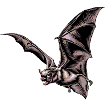Museum, University of Nebraska State

University of Nebraska State Museum: Mammalogy Papers
Document Type
Article
Date of this Version
6-1-1984
Citation
Biological Journal of the Linnean Society (1984) 21: 387-408.
Abstract
Large animalivorous bats include carnivorous, piscivorous and insectivorous microchiropterans. Skull proportions and tooth morphology are examined and interpreted functionally. Four wide-faced bats from four families are convergent in having wide skulls, large masseter muscle volumes and stout jaws, indicating a powerful bite. Three of the four also have long canine teeth relative to their maxillary toothrows. Carnivorous bats have more elongate skulls, larger brain volumes and larger pinnae. The wide-faced bats are all oral emitters and have heads positively tilted relative to the basicranial axis. The carnivorous species are nasal-emitting bats and have negatively tilted heads. The orientation of the head relative to the basicranial axis affects several characters of the skull and jaws and is not correlated with size. The speculation that the type of echolocation may be more of a determinant of evolutionary change than the feeding mechanism is addressed. Wide-faced bats are thought to be capable of eating hard prey items (durophagus) and are probably non- discriminating, aurally less sophisticated insect generalists while the carnivorous and non-durophagus insectivorous bats may be more discriminating and aurally more sophisticated in what they eat.


Comments
Copyright © 1984, Linnean Society of London. Published by Blackwell Publishing. Used by permission. The definitive version is available at http://www.blackwell-synergy.com